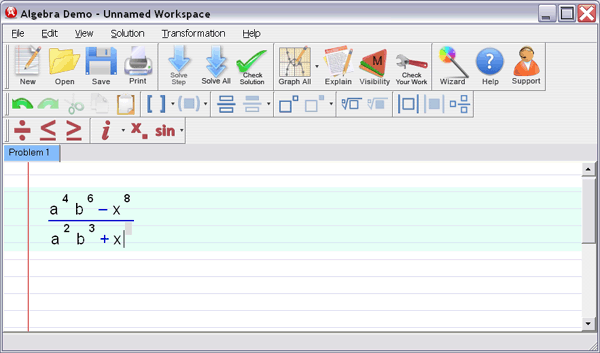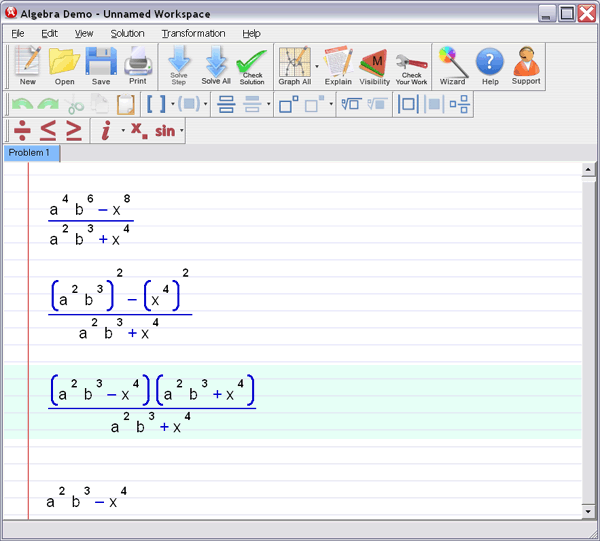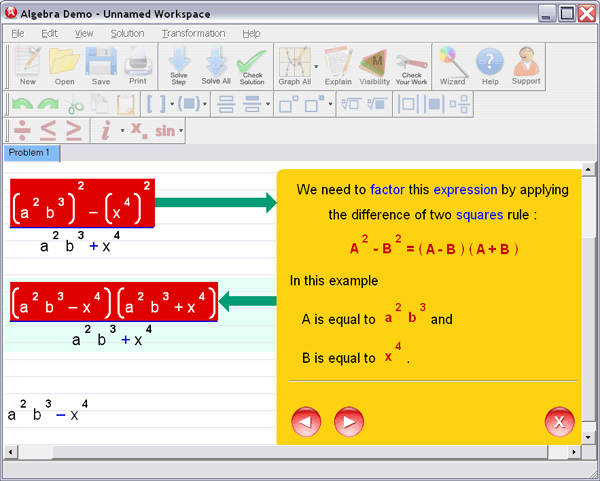Introduction to Mathematical Modeling
Course Location & Time: Classroom South 107, MWF
10:00-10:50
Textbook: Explorations In College Algebra, 4th Edition, by Kime, Clark
and Michael, John Wiley & sons.
ISBN: 9780470281482, and Wiley Plus.
Note: This course syllabus provides a general plan for the
course; deviations may be necessary.
1. COURSE DESCRIPTION. Mathematical modeling uses graphical, numerical,
symbolic, and verbal
techniques to describe and explore real-world data and phenomena. Emphasis is on
the use of elementary
functions to investigate and analyze applied problems and questions, on the use
of appropriate supporting
technology, and on the effective communication of quantitative concepts and
results. THIS COURSE IS
NOT AN APPROPRIATE PREREQUISITE FOR PRECALCULUS OR CALCULUS. Students who must
take pre-calculus must understand the implications of taking MATH 1101 (See the
instructor immediately
if you have any questions).
2. PREREQUISITE. Knowledge of high school algebra II, or equivalent, is
expected. This includes
algebraic expressions , first degree equations and inequalities, exponents,
radicals , solving and graphing
linear equations, factoring quadratic expressions, and other topics.
3. COURSE OBJECTIVES.
Algebra. Students will demonstrate the ability to:
a. Graph points.
b. Graph linear, piecewise linear, exponential, logarithmic, and quadratic
equations and
functions, as well as identify horizontal asymptotes.
c. Determine the equation of a line given two points or one point and the slope .
d. Determine the absolute value of a quantity.
e. Solve and estimate solutions to linear, quadratic, exponential, and
logarithmic equations ,
including use of the properties of exponents and common and natural logarithms.
f. Solve linear systems of two equations by substitution and elimination ,
including systems
that have a unique solution, no solution, or many solutions.
g. Simplify expressions using the laws of exponents and logarithms.
h. Calculate average rate of change of any function.
i. Perform arithmetic calculations to answer questions regarding two-variable
data
presented in tabular, graphical, or equation form.
j. Express and compare very large and very small numbers using scientific
notation and
orders of magnitude .
k. Factor quadratic expressions.
l. Complete the square of quadratic expressions.
m. Express the square root of negative numbers in terms of
the imaginary unit, i.
n. Given conversion factors, convert units of measure.
o. Use the quadratic formula to solve quadratic equations
Functions. Students will demonstrate:
a. The understanding of the definitions of function, domain, range, independent
and
dependent variables, and input and output.
b. The ability to determine if tables, graphs, and equations represent
functions.
c. The ability to determine the domain and range of functions as mathematical
abstractions
or in a physical context.
d. The ability to determine from the graph of a function the values of the
independent
variable for which the function increases, decreases, or remains constant.
Linear and piecewise linear functions. Students will demonstrate the ability to:
a. Determine when two real-world variables are related by a linear or piecewise
linear
function.
b. Calculate, and interpret average rate of change as slope .
c. Model the behavior of two real-world variables that are directly proportional
or are
related by a linear or piecewise linear function using tables, graphs,
equations.
d. Evaluate linear and piecewise linear functions.
e. Use a linear function to approximate the value of a non-linear function.
f. Interpret the intersection of the graphs of linear functions as equilibrium
points.
Exponential Functions. Students will demonstrate the ability to:
a. Determine when two real-world variables are related by an exponential
function.
b. Model the behavior of two real-world variables that are related by an
exponential
function using tables, graphs, equations, or combinations thereof including such
applications as population growth and decay, radioactive decay, simple and
compound
interest, inflation, the Malthusian dilemma, musical pitch, and the Rule of 70.
c. Change the base of an exponential function to determine rate of growth/decay,
growth/decay factor, and effective and nominal interest rate.
d. Express continuous growth/decay in terms of the number e.
e. Evaluate exponential functions.
f. Determine the exponential equation model from the table or graphical model.
g. Compare linear to exponential growth.
Logarithmic Functions. Students will demonstrate:
a. The ability to determine when two real-world variables are related by a
logarithmic
function.
b. The ability to model the behavior of two real-world variables that are
related by a
logarithmic function using tables, graphs, equations, or combinations thereof
including
such applications as pH and the decibel system.
c. The understanding of the natural logarithm.
d. The ability to graph logarithmic functions.
Quadratic Functions. Students will demonstrate the ability to:
a. Estimate horizontal intercepts of quadratic functions from their graphs.
b. Determine the horizontal intercepts of quadratic functions in factored form.
c. Determine the vertex, axis of symmetry, and horizontal and vertical
intercepts of
quadratic functions in either the a-b-c or a-h-k forms.
d. Convert quadratic functions from the a-b-c form to the
a-h-k form and vice versa.
e. Determine when two real-world variables are related by a quadratic function
by
calculating the average rate of change of the average rates of change.
f. Model the behavior of two real-world variables that are related by a
quadratic function
using tables, graphs, equations, or combinations thereof including such
applications as
maximum area for fixed perimeter, minimum perimeter for fixed area, free fall,
maximum profit, and break-even analysis.
4. COURSE COVERAGE. We will cover the following sections from the text:
Chapter 1  Making Sense of Data and Function (1.1 - 1.5) Making Sense of Data and Function (1.1 - 1.5)
Chapter 2  Rates of Change and Linear Functions (2.1 - 2.8) Rates of Change and Linear Functions (2.1 - 2.8)
Chapter 3  When Lines Meet: Linear Systems (3.1 - 3.2, 3.4) When Lines Meet: Linear Systems (3.1 - 3.2, 3.4)
Chapter 4  The Laws of Exponents and Logarithms: Measuring the Universe (4.1 -
4.7) The Laws of Exponents and Logarithms: Measuring the Universe (4.1 -
4.7)
Chapter 5  Growth and Decay: An Introduction to Exponential Functions (5.1 - 5.6) Growth and Decay: An Introduction to Exponential Functions (5.1 - 5.6)
Chapter 6  Logarithmic Links: Logarithmic and Exponential Functions (6.1 - 6.5) Logarithmic Links: Logarithmic and Exponential Functions (6.1 - 6.5)
Chapter 8  Quadratic and Other Polynomial Functions (8.1 - 8.4) Quadratic and Other Polynomial Functions (8.1 - 8.4)
IMPORTANT NOTE: Georgia State University and its faculty are not responsible for
outcomes due to
individual technical issues, nor scheduled WileyPlus downtimes. It is expected
that the students will be
responsible for completing their work in a timely fashion as to alleviate any
pressures these scheduled
downtimes occur. All students will be notified of these downtimes by WileyPlus
through the
announcements page of the course.
5. COURSE EVALUATION. Your course grade will be determined as follows:
a. Tests (Three close book, close notes tests) 45%
b. WileyPlus online homework and quizzes 15%
c. Excel Projects 10%
d. In Class Activities 5%
e. Final Exam (Comprehensive, close book, close notes final exam) 25%
Example of Course Grade Computation:
Test Grades: T1 = 88, T2 = 72, T3 = 68,
WileyPlus online homeworks and quizzes average = 85
Excel Project average = 90
In Class Activities =80
Final Exam=76
Course Grade: 0.15*(88+72+68) +0.15*85+ 0.10*90 + 0.05*80+0.25*76 = 79
6. GRADING SCALE. We will use the following grading scale:
A: 90 - 100, B+: 87 - 89, B: 80 -86, C+: 77 - 79, C: 70 - 76, D: 60 - 69, F:
Below 60
7. Makeup Policy: No make-up exams will be given unless in some extreme
situations. Absence from the
final exam will result in a grade of F for the course unless arrangements are
made PRIOR (at least one
week before the final exam) to its administration.
MATH 1101 Homework Assignments
Kime, Clark and Michael 4th Edition
| Section |
Assignment |
1.1
|
AA (Algebra Aerobics) 1, 2, 3, 4, 6, 9, 10
E (Exercise) 2, 5, 7, 9, 11, 12, 22 |
1.2
|
AA 1.2a 2, 3; 1.2b 1, 3, 4
E 10, 11, 12, 14, 15, 17 |
1.3
|
AA 1, 2, 3, 4, 5, 6, 7, 8
E 1, 2, 3, 4, 5, 6, 7, 11 |
1.4
|
AA 1.4a 1, 2, 3, 4, 5, 6, 7, 8, 9; 1.4b 1, 2
E 1-18 (all) |
| 1.5 |
E 1, 4, 5 |
| Chapter 1 Review |
11, 15, 22, 23, 24 |
2.1
|
AA (Algebra Aerobics) 1, 2, 3, 4, 5, 6
E (Exercise) 1, 7, 8, 9, 14, 15, 16 |
2.2
|
AA 1, 3
E 1, 2, 3, 5 |
2.3
|
AA 1, 4, 5, 6
E 2, 3, 6, 7, 9, 10, 11, 13, 15 |
2.4
|
AA 1, 2
E 2, 3 |
2.5
|
AA 3, 5, 6, 7, 8, 9, 10, 11
E 1, 5, 7, 9, 11, 14, 19, 21, 23 |
2.6
|
AA 1, 3, 5, 7
E 1, 3, 5, 6, 7, 11 |
2.7
|
AA 1, 3, 5, 7, 9, 11, 15, 17
E 1, 3, 5, 7, 9, 11, 13, 15, 19 |
2.8
|
AA 2.8a 1, 3, 5; 2.8b 1, 2, 3, 5, 7, 9, 11, 13,
15; 2.8c 3, 4
E 1, 7, 9, 13, 17, 19, 21, 27, 28 |
| Chapter 2 Review |
3, 9, 13, 14, 21 |
3.1
|
AA (Algebra Aerobics) 2, 3, 4
E (Exercise) 1, 2, 6, 7, 8, 9 |
3.2
|
AA 3.2a 1, 2, 3, 4; 3.2b 1, 2, 4, 5, 6
E 2, 3, 4, 5, 6, 7, 8, 9, 13, 15, 17, 18, 19, 20 |
3.4
|
AA 1, 2, 3, 4
E 1, 3, 4, 5, 7, 10 |
| Chapter 3 Review |
2, 3 |
4.1
|
AA (Algebra Aerobics) 1, 6, 7, 9, 10
E (Exercise) 1, 5, 7, 9, 11, 13 |
4.2
|
AA 4.2a 1, 2, 3, 4, 5, 7; 4.2b 2, 3
E 1, 3, 5, 7, 9, 11, 13, 15, 19, 21 |
4.3
|
AA 1, 3, 4, 5
E 1, 3, 5, 7, 9, 11, 15 |
4.4
|
AA 3, 4, 5, 6, 7, 8
E 1, 2, 3, 7, 8, 9, 11, 12, 19 |
4.5
|
AA 4.5a 1, 2, 4, 5, 6, 8, 9; 4.5b 1, 2, 4, 5
E1, 3, 5, 6, 7, 9, 10, 15, 17, 18 |
4.6
|
AA 1, 2, 3, 4, 5, 6
E 1, 3, 10, 11 |
4.7
|
AA 4.7a 1, 3, 4, 5; 4.7b 1, 3, 4, 5
E 3, 7, 9, 11, 13, 19 |
| Chapter 4 Review |
2, 5, 7, 8, 15, 19 |
5.1
|
AA (Algebra Aerobics) 1, 2, 3, 4
E (Exercise) 1, 3, 5, 7, 9, 10, 11 |
5.2
|
AA 1, 2, 3, 4, 5, 6
E 1, 5, 7, 9, 10, 14 |
5.3
|
AA 1, 2, 3, 4, 5
E 1, 2, 3, 5, 7, 8a), 12, 13, 16 |
5.4
|
AA 1
E 1, 3 |
5.5
|
AA 1, 2, 3
E 1, 3, 5, 7, 9, 10, 11, 12, 13 |
5.6
|
AA 5.6a 1, 2, 3, 4; 5.6b 1, 3, 7; 5.6c 1
E 1, 3, 5, 10, 11, 14, 16, 23 |
| Chapter 5 Review |
1, 3, 7, 8 |
6.1
|
AA (Algebra Aerobics) 6.1a 1, 4; 6.1b 1, 2, 4, 5,
6;
6.1c 1, 2, 3, 5, 6
E (Exercise) 5, 6, 7, 8, 9, 13, 16, 17, 18 |
6.2
|
AA 1, 2, 6, 7, 9, 10
E 1, 2, 3, 4, 5, 9, 10, 11, 15, 16 |
6.3
|
AA 1, 2, 3, 4, 5, 6, 8
E 1, 3, 5, 7, 8, 9, 11, 12, 13, 17, 19, 21 |
| 6.4 |
AA 5, 6 |
6.5
|
AA 1, 2, 3, 4
E1, 3, 4, 5, 6, 8, 13 |
| Chapter 6 Review |
1, 3, 10, 11, 16 |
8.1
|
AA (Algebra Aerobics) 1, 3, 6
E (Exercise) 2, 6, 9, 17, 19 |
8.2
|
AA 8.2b 7; 8.2c 1, 2, 3, 5, 6, 9, 10, 11, 12
E 1, 6, 7, 8, 15, 18, 21a), 25, 29 |
8.3
|
AA 8.3b 1, 2, 3, 4
E 3, 7, 9 |
8.4
|
AA 1, 2
E 2, 4, 5, 11 |
| Chapter 8 Review |
1, 8, 13, 15 |
Start solving your Algebra Problems
in next 5 minutes!
 |
 |
 |
|
Algebra Helper
Download (and optional CD)
Only $39.99
|
|
Click to Buy Now:
OR
|
|
|
 |
 |
 |
|
2Checkout.com is an authorized reseller
of goods provided by Sofmath
|
|
Attention: We are
currently running a special promotional offer
for Algebra-Answer.com visitors -- if you order
Algebra Helper by midnight of
February 5th
you will pay only $39.99
instead of our regular price of $74.99 -- this is $35 in
savings ! In order to take advantage of this
offer, you need to order by clicking on one of
the buttons on the left, not through our regular
order page.
If you order now you will also receive 30 minute live session from tutor.com for a 1$!
|
You Will Learn Algebra Better - Guaranteed!
Just take a look how incredibly simple Algebra Helper is:
Step 1
: Enter your homework problem in an easy WYSIWYG (What you see is what you get) algebra editor:

Step 2 :
Let Algebra Helper solve it:

Step 3 : Ask for an explanation for the steps you don't understand:

Algebra Helper can solve problems in all the following areas:
- simplification of algebraic expressions (operations
with polynomials (simplifying, degree, synthetic division...), exponential expressions, fractions and roots
(radicals), absolute values)
- factoring and expanding expressions
- finding LCM and GCF
-
(simplifying, rationalizing complex denominators...)
- solving linear, quadratic and many other equations
and inequalities
(including basic logarithmic and exponential equations)
- solving a system of two and three linear equations
(including Cramer's rule)
- graphing curves (lines, parabolas, hyperbolas, circles,
ellipses, equation and inequality solutions)
- graphing general functions
- operations with functions (composition, inverse, range, domain...)
- simplifying logarithms
- basic geometry and trigonometry
(similarity, calculating trig functions, right triangle...)
- arithmetic and other pre-algebra topics
(ratios, proportions, measurements...)
ORDER NOW!
 |
 |
 |
|
Algebra Helper
Download (and optional CD)
Only $39.99
|
|
Click to Buy Now:
OR
|
|
|
 |
 |
 |
|
2Checkout.com is an authorized reseller
of goods provided by Sofmath
|
|
|
 |
| |
| "It
really helped me with my homework. I was
stuck on some problems and your software walked me
step by step through the process..." |
| C. Sievert, KY
| |
| |
 |
| |
Sofmath
19179 Blanco #105-234
San Antonio, TX 78258
|
Phone:
(512) 788-5675
Fax: (512) 519-1805
| | |



